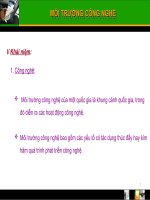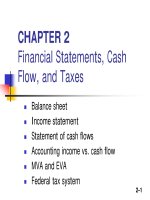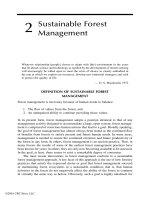Strategic management chapter 2 general environment
Bạn đang xem bản rút gọn của tài liệu. Xem và tải ngay bản đầy đủ của tài liệu tại đây (511.22 KB, 34 trang )
Figure 2.1
The External Environment
© 2015 Cengage Learning. All rights reserved. May not be copied, scanned, or duplicated, in whole or in part, except for use as permitted in a license distributed with a certain product or service or otherwise on a password-protected
website for classroom use.
2–1
General Environment
•
Dimensions in the broader society that influence an industry and the firms within it:
–
Demographic
–
Economic
–
Political/legal
–
Sociocultural
–
Technological
–
Global
–
Physical
© 2015 Cengage Learning. All rights reserved. May not be copied, scanned, or duplicated, in whole or in part, except for use as permitted in a license distributed with a certain product or service or otherwise on a password-protected
website for classroom use.
2–2
Table 2.1
The General Environment: Segments and Elements
© 2015 Cengage Learning. All rights reserved. May not be copied, scanned, or duplicated, in whole or in part, except for use as permitted in a license distributed with a certain product or service or otherwise on a password-protected
website for classroom use.
2–3
Industry Environment
•
The set of factors directly influencing a firm and its competitive actions and
competitive responses
–
Threat of new entrants
–
Power of suppliers
–
Power of buyers
–
Threat of product substitutes
–
Intensity of rivalry among competitors
© 2015 Cengage Learning. All rights reserved. May not be copied, scanned, or duplicated, in whole or in part, except for use as permitted in a license distributed with a certain product or service or otherwise on a password-protected
website for classroom use.
2–4
Competitor Analysis
•
Gathering and interpreting information about all
of the companies that the firm competes
against.
•
Understanding the firm’s competitor
environment complements the insights
provided by studying the general and industry
environments.
© 2015 Cengage Learning. All rights reserved. May not be copied, scanned, or duplicated, in whole or in part, except for use as permitted in a license distributed with a certain product or service or otherwise on a password-protected
website for classroom use.
2–5
External Environmental Analysis
•
General environment
–
•
Focused on the future
Industry environment
–
Focused on factors and conditions influencing a firm’s profitability within an
industry
•
Competitor environment
–
Focused on predicting the dynamics of competitors’ actions, responses and
intentions
© 2015 Cengage Learning. All rights reserved. May not be copied, scanned, or duplicated, in whole or in part, except for use as permitted in a license distributed with a certain product or service or otherwise on a password-protected
website for classroom use.
2–6
Table 2.2
Components of the External Environmental Analysis
Scanning
•
Identifying early signals of environmental changes and trends
Monitoring
•
Detecting meaning through ongoing observations of environmental changes and
trends
Forecasting
•
Developing projections of anticipated outcomes based on monitored changes and
trends
Assessing
•
Determining the timing and importance of environmental changes and trends for firms’
strategies and their management
© 2015 Cengage Learning. All rights reserved. May not be copied, scanned, or duplicated, in whole or in part, except for use as permitted in a license distributed with a certain product or service or otherwise on a password-protected
website for classroom use.
2–7
Opportunities and Threats
•
Opportunity
–
A condition in the general environment that, if
exploited effectively, helps a firm achieve strategic
competitiveness.
•
Threat
–
A condition in the general environment that may
hinder
a firm’s efforts to achieve strategic competitiveness.
© 2015 Cengage Learning. All rights reserved. May not be copied, scanned, or duplicated, in whole or in part, except for use as permitted in a license distributed with a certain product or service or otherwise on a password-protected
website for classroom use.
2–8
Segments of the General Environment
Geographic
Geographic
distribution
distribution
Age
Age
Ethnic
Ethnic mix
mix
structure
structure
Population
Population
The Demographic
size
size
Segment
Income
Income distribution
distribution
© 2015 Cengage Learning. All rights reserved. May not be copied, scanned, or duplicated, in whole or in part, except for use as permitted in a license distributed with a certain product or service or otherwise on a password-protected
website for classroom use.
2–9
Segments of the General Environment (cont’d)
•
The Economic Segment
–
Uncertainty in
•
Market growth rates
•
Consumer demand
•
Inflation and interest rates
•
Trade deficits or surpluses
•
Budget deficits or surpluses
•
Personal and business savings rates
•
Gross domestic product
© 2015 Cengage Learning. All rights reserved. May not be copied, scanned, or duplicated, in whole or in part, except for use as permitted in a license distributed with a certain product or service or otherwise on a password-protected
website for classroom use.
2–10
Segments of the General Environment (cont’d)
•
The Political/Legal Segment
–
Regulations
–
Consumer privacy laws
–
Lobbying
–
Antitrust, deregulation laws
–
Taxation
© 2015 Cengage Learning. All rights reserved. May not be copied, scanned, or duplicated, in whole or in part, except for use as permitted in a license distributed with a certain product or service or otherwise on a password-protected
website for classroom use.
2–11
Segments of the General Environment (cont’d)
•
The Sociocultural Segment
–
Changing attitudes and cultural values
•
Attitudes and approaches to health care
•
Attitudes about quality of worklife
•
Diverse and aging workforce
•
Women in the workplace
•
Concerns about environment
•
Shifts in work and career preferences
•
Shifts in product and service preferences
© 2015 Cengage Learning. All rights reserved. May not be copied, scanned, or duplicated, in whole or in part, except for use as permitted in a license distributed with a certain product or service or otherwise on a password-protected
website for classroom use.
2–12
Segments of the General Environment (cont’d)
•
The Technological Segment
–
Product innovations
–
Rapid technological change and the risk of disruption
–
Knowledge application
–
Growth of the Internet
–
New communication technologies
© 2015 Cengage Learning. All rights reserved. May not be copied, scanned, or duplicated, in whole or in part, except for use as permitted in a license distributed with a certain product or service or otherwise on a password-protected
website for classroom use.
2–13
Segments of the General Environment (cont’d)
trends
geopolitical
Important
Critical
global niche
markets
attributes
Global Focusing
Global Focusing
cultural and institutional
Different
Growth of
the informal economy
© 2015 Cengage Learning. All rights reserved. May not be copied, scanned, or duplicated, in whole or in part, except for use as permitted in a license distributed with a certain product or service or otherwise on a password-protected
website for classroom use.
2–14
Segments of the General Environment (cont’d)
•
The Physical Environment Segment
–
Emerging trends oriented to sustaining the world’s physical environment
–
Recognition of the interactive influence of ecological, social, and economic systems
–
Growing concerns for sustainable industry development and increased corporate social
responsibility for the future effects of globalized operations
© 2015 Cengage Learning. All rights reserved. May not be copied, scanned, or duplicated, in whole or in part, except for use as permitted in a license distributed with a certain product or service or otherwise on a password-protected
website for classroom use.
2–15
Figure 2.2
The Five Forces of Competition Model
© 2015 Cengage Learning. All rights reserved. May not be copied, scanned, or duplicated, in whole or in part, except for use as permitted in a license distributed with a certain product or service or otherwise on a password-protected
website for classroom use.
2–16
Threat of New Entrants:
Barriers to Entry
•
•
•
•
•
•
•
•
Economies of scale
Product differentiation
Capital requirements
Switching costs
Access to distribution channels
Cost disadvantages independent of scale
Government policy
Expected retaliation
© 2015 Cengage Learning. All rights reserved. May not be copied, scanned, or duplicated, in whole or in part, except for use as permitted in a license distributed with a certain product or service or otherwise on a password-protected
website for classroom use.
2–17
Barriers to Entry
•
Economies of Scale
–
Marginal improvements in efficiency that a firm experiences as it incrementally increases
its size
•
Factors (advantages and disadvantages) related to large- and small-scale entry
–
Flexibility in pricing and market share
–
Costs related to scale economies
–
Competitor retaliation
© 2015 Cengage Learning. All rights reserved. May not be copied, scanned, or duplicated, in whole or in part, except for use as permitted in a license distributed with a certain product or service or otherwise on a password-protected
website for classroom use.
2–18
Barriers to Entry (cont’d)
• Product Differentiation
–
–
–
Unique products
–
Products at competitive prices
Physical facilities
Inventories
Marketing activities
Availability of capital
One-time costs customers incur buying from a different supplier
•
•
•
Customer loyalty
• Capital Requirements
–
–
–
–
• Switching Costs
New equipment
Retraining employees
Psychic costs of ending a relationship
• Distribution Channel Access
–
–
–
Stocking or shelf space
Price breaks
Cooperative advertising allowances
© 2015 Cengage Learning. All rights reserved. May not be copied, scanned, or duplicated, in whole or in part, except for use as permitted in a license distributed with a certain product or service or otherwise on a password-protected
website for classroom use.
2–19
Barriers to Entry (cont’d)
•
Cost Disadvantages Independent of Scale
–
–
–
•
Proprietary product technology
•
Expected retaliation
–
Responses by existing competitors may
Favorable access to
depend on a firm’s present stake in the industry
raw materials
(available business options)
Desirable locations
Government policy
–
–
Licensing and permit requirements
Deregulation of industries
© 2015 Cengage Learning. All rights reserved. May not be copied, scanned, or duplicated, in whole or in part, except for use as permitted in a license distributed with a certain product or service or otherwise on a password-protected
website for classroom use.
2–20
Bargaining Power of Suppliers
•
Supplier power increases when:
–
Suppliers are large and few in number.
–
Suitable substitute products are not available.
–
Individual buyers are not large customers of suppliers and there are many of them.
–
Suppliers’ goods are critical to the buyers’ marketplace success.
–
Suppliers’ products create high switching costs.
–
Suppliers pose a threat to integrate forward into buyers’ industry.
© 2015 Cengage Learning. All rights reserved. May not be copied, scanned, or duplicated, in whole or in part, except for use as permitted in a license distributed with a certain product or service or otherwise on a password-protected
website for classroom use.
2–21
Bargaining Power of Buyers
•
Buyer power increases when:
–
Buyers are large and few in number.
–
Buyers purchase a large portion of an industry’s total output.
–
Buyers’ purchases are a significant portion of a supplier’s annual revenues.
–
Buyers’ switching costs are low.
–
Buyers can pose threat to integrate backward into the sellers’ industry.
© 2015 Cengage Learning. All rights reserved. May not be copied, scanned, or duplicated, in whole or in part, except for use as permitted in a license distributed with a certain product or service or otherwise on a password-protected
website for classroom use.
2–22
Threat of Substitute Products
•
The threat of substitute products increases when:
–
Buyers face few switching costs.
–
The substitute product’s price is lower.
–
Substitute product’s quality and performance are equal to or greater than the
existing product.
•
Differentiated industry products that are valued by customers reduce this
threat.
© 2015 Cengage Learning. All rights reserved. May not be copied, scanned, or duplicated, in whole or in part, except for use as permitted in a license distributed with a certain product or service or otherwise on a password-protected
website for classroom use.
2–23
Intensity of Rivalry Among Competitors
•
Industry rivalry increases when:
–
There are numerous or equally balanced competitors.
–
Industry growth slows or declines.
–
There are high fixed costs or high storage costs.
–
There is a lack of differentiation opportunities or low switching costs.
–
When the strategic stakes are high.
–
When high exit barriers prevent competitors from leaving the industry.
© 2015 Cengage Learning. All rights reserved. May not be copied, scanned, or duplicated, in whole or in part, except for use as permitted in a license distributed with a certain product or service or otherwise on a password-protected
website for classroom use.
2–24
Interpreting Industry Analyses
Low entry barriers
Suppliers and buyers have strong
positions
Unattractive
Strong threats from substitute
Industry
products
Intense rivalry among competitors
(Low profit potential)
© 2015 Cengage Learning. All rights reserved. May not be copied, scanned, or duplicated, in whole or in part, except for use as permitted in a license distributed with a certain product or service or otherwise on a password-protected
website for classroom use.
2–25









